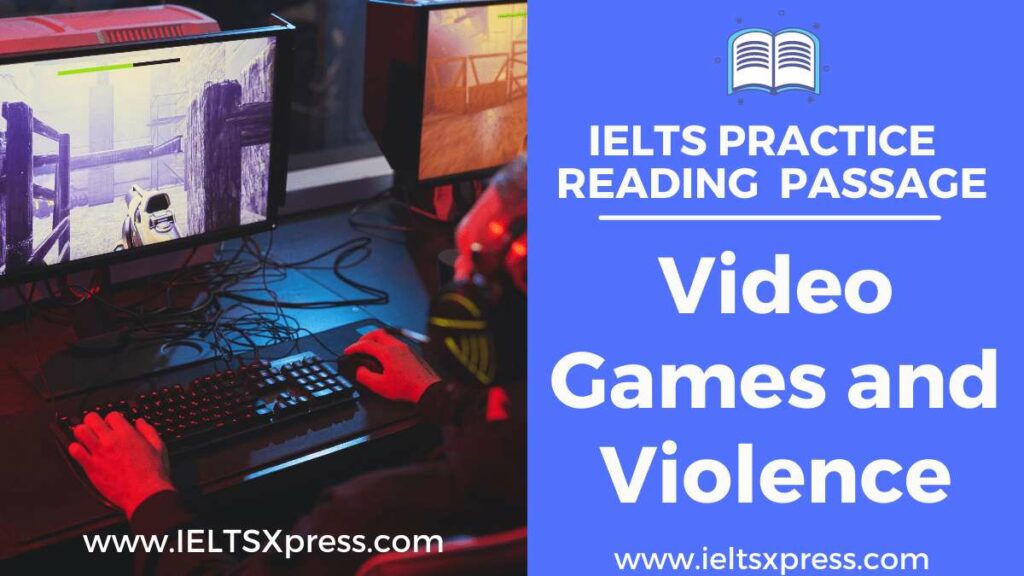Video Games and Violence IELTS Reading Passage with Answers
Reading Passage 3
You should spend about 20 minutes on Questions 27-40 which are based on Reading Passage 3 below.
Video Games and Violence
For quite some time now, video games that involve significant amounts of violence have been blamed for growing numbers of violence by young people, the demographic most likely to play these games. Debate about this has even reached the courts, with both sides of the argument claiming that the scientific literature supports their opinions. Some experts involved have proclaimed that the debate is scientifically settled and that only people holding personal concerns and biases oppose these established truths. Scientifically, two competing social theories have been formulated about the potential effects of video game violence. The first is that video games increase violence because they teach players how to be violent and reinforce violent tendencies. The second theory is that video games have a possibly beneficial effect, because they provide a socially acceptable outlet for the release of aggression and thereby promote better mental health.
Articles reviewing the effects of video games on general populations have found links between playing violent video games and changes in behaviour, and/or thought process, with some finding that people who played realistic violent games for 45 minutes had a greater increase in violent and aggressive feelings than persons who played unrealistic violent video games or non-violent video games for the same period. What seems clear though is that certain populations are more at risk and/or are more likely to play violent video games than others. Studies suggest that at-risk individuals are usually male, have pre-existing personality disorders or traits, for example a conduct disorder, have pre-existing mental health conditions, have had difficult or traumatic upbringings, and are insecure with poor self-esteem. Children with attention deficit disorder were also seen to be at a higher risk of showing addictive behaviour to violent video games and that violent video games might be a significant risk variable for aggressive behaviour in persons who already have aggressive personality traits. There are, of course, plenty of other groups of people (probably the majority of users) who play and enjoy video games, with or without violence, that have no character disorders at all. Another recent key report which relied on parents’ self-report of their children’s video gameplaying behaviours suggests that spending a large amount of time playing violent video games was correlated with troublesome behaviour and poor academic achievement. The same study also indicated that children who played more educational games had more positive outcomes.
What is interesting is that the comic book debate of the 1950’s is eerily similar when compared to the current debate about the effects of video games on children. In 1954, the US Senate Subcommittee on Juvenile Delinquency held hearings on the effects of comic books on America’s youth. The primary focus of the Senate hearings was ‘crime and horror’ comic books, some of which graphically showed horrific images, such as dismembered bodies. Concerns were voiced that these comics would lead to a decline in public morals, an increase in violence and aggression, an increase in general lawlessness, and societal disrespect and deterioration. Medical and social science experts became involved in the debate, writing articles in reputable journals. Many of the concerns that dominate the current video game debate were also expressed and it could show the frequently experienced perception that violent behaviour is always more prevalent in the present than in the past and that people just search for a scapegoat on which to blame it.
Although many articles have suggested a connection between violent video games and aggression, several studies have found no such relationship. One study in fact showed that non-gamers and excessive gamers both had lower self-reported mental wellness scores than low to moderate gamers. This finding suggests that excessive playing may be detrimental, but that there are some protective and non-harmful consequences to playing in moderation. This finding is in line with social theory, which suggests that video games, like sports, may provide an outlet for individuals to work through aggression and, therefore, have better mental functioning and overall lower levels of aggression. The same study pointed to the positive attributes of violent video game playing, such as improved visual-spatial coordination, increased peripheral attention, and increased decision-making capabilities. People who play a lot of video games also generally have better overall computer skills than people who do not.
Another study examining the multivariate risk issues for youth violence showed that the most common positive predictors of youth violence were delinquent peer influences, antisocial personality traits, depression, and parents or guardians who use psychological abuse in family relationships. The factors that were not found to be predictive of youth violence included neighbourhood quality, parental use of domestic physical violence in intimate relationships, and exposure to violent television or video games.
A recent neurological study provided further evidence that video games do not increase violent behaviour by users. The study examined whether there was a change in brain imaging that suggested a loss of distinction between virtual and actual violence in players of violent video games compared with controls. What was found was that the ability to differentiate automatically between real and virtual violence was not diminished by a long-term history of violent video game play, and nor were gamers’ neural responses to real violence subject to desensitisation processes. This would indicate that video games do not cause people to lose their grip on what is real in comparison with what is fantasy.
Many questions are raised by the split nature of the scientific literature regarding violence and video games and it should also be remembered that a correlation does not prove a causation. Stakeholders need to examine the current video game debate in order to decide how to sensibly influence social policy.
Questions 27-33
Do the following statements agree with the information given in the text?
In boxes 27-33 on your answer sheet write:
TRUE if the statement agrees with the information
FALSE if the statement contradicts the information
NOT GIVEN if there is no information on this
27 Violent video games are most likely to be played by people in their youth and middle age.
28 It has been claimed that people who still feel the effects of violent video games are not decided and clear have vested interests in the debate.
29 It is claimed that men and women are more or less equally threatened by the effects of violent video games.
30 One study has found a link between usage of violent video games and poor school performance.
31 Various violent video games are based on stories previously published in comic books.
32 Some of the comic books of the 1950’s had shocking images of mutilated people.
33 It has been claimed that violence has always been present in society and video games are just the latest thing to blame it on.
Questions 34-39
Complete the table below.
Write NO MORE THAN THREE WORDS from the text for each answer.
Write your answers in boxes 34-39 on your answer sheet.
Studies Defending the Use of Violent Video Games
| Study 1 | ● Non-gamers and excessive gamers had similar grading in terms of 34 _________ ● It shows excessive gaming can have protective effects. ● Similar ideas in social theory – users can rid themselves of 35 _________and therefore have a better mental condition. ● Gaming can improve visual-spatial coordination, peripheral attention, 36 _________ And computer skills. |
| Study 2 | ● It examined the various risk factors for youth violence – peers, personality, depression and psychological abuse. ● Non-factors were 37 _________, violence at home and violent TV and video games. |
| Study 3 | ● A neurological study examining variations in 38 _________ when users interacted with virtual or real violence. ● Results showed that users’ differentiation between virtual or real violence was not affected by the use of violent video games. ● The 39 _________ with regards to real violence in users’ neural reactions were also not affected. ● It shows video games do not affect people’s perceptions of what is real or what is fantasy. |
Question 40
Choose the correct letter, A, B, C or D.
Write the correct letter in box 40 on your answer sheet.
40 What is the writer’s purpose in Reading Passage 3?
A To defend the use of violent video game usage.
B To discourage people from using violent video games.
C To examine examples of violence by users of violent video games.
D To review what has been discovered about the effects of violent video games.
Video Games and Violence IELTS Reading Passage Answers
Practice with Expert IELTS Tutors Online
Apply Code "IELTSXPRESS20" To Get 20% off on IELTS Mock Test
27. FALSE
28. TRUE
29. FALSE
30. TRUE
31. NOT GIVEN
32. TRUE
33. TRUE
34. (mental) wellness scores
35. aggression
36. decision-making (capabilities)
37. neighborhood (quality)
38. brain imaging
39. desensitization (processes)
40. D
Also Check: Hydrogen Cars IELTS Reading Passage with Answers





